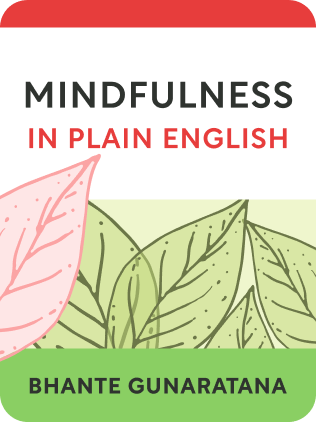

This article is an excerpt from the Shortform book guide to "Mindfulness in Plain English" by Bhante Gunaratana. Shortform has the world's best summaries and analyses of books you should be reading.
Like this article? Sign up for a free trial here .
Looking for a mindfulness meditation starter guide? What are some things you need to know to start practicing meditation?
According to Henepola Gunaratana, a Buddhist monk from Sri Lanka and the author of a mindfulness meditation guide Mindfulness in Plain English, meditation is learned by doing, not by following dogmatic prescriptions. However, there are certain meditation practices that have been optimized over millennia, and they’re worth trying out.
The following guidelines are taken from Mindfulness in Plain English, a practical mindfulness meditation guide that is specifically written for beginners.
Mindfulness Meditation: Starter Guide
Do you get irritated, angry, anxious, or emotional more easily than you would like? Mindfulness meditation may be worth trying. Being mindful means observing your thoughts and emotions as they arise, without succumbing to your typical kneejerk reactions. You discover the roots of your anger, greed, and selfishness, and you learn to banish these psychic irritants. Ultimately, you become more at peace, and friendlier to other people.
The below guidelines are taken from Mindfulness in Plain English, an approachable introduction to mindfulness and meditation. Written by Buddhist monk Bhante Henepola Gunaratana, this is practical mindfulness meditation guide that is mostly secular and truly written in plain English with little spiritual mumbo-jumbo.
What to Do With Your Body
The body position is meant to provide stability to remove distractions and create immobility of the mind.
Sit with your back straight. The spine should be erect, with the head in line with the spine. Be relaxed, not stiff. Have no muscular tension.
- Straightness invites alertness. Slouching invites drowsiness.
Your clothing should be loose and soft. Don’t wear clothing so tight it restricts blood flow or nerve sensation. Take your shoes off.
You can choose to sit on the floor on in a chair.
When sitting on the floor:
- Use a cushion that is relatively firm, at least 3 inches thick when compressed.
- Sit close to the front edge of cushion, and let your crossed legs rest on the floor in front. Use some padding to protect shins and ankles from pressure.
- Sitting too far back causes the front edge of cushion to press into thigh and pinch nerves.
- Fold your legs in a style you’re comfortable with. In ascending order of preference:
- Native American style – right foot tucked under left knee, left foot under right knee.
- Burmese style – both legs lie flat on floor from knee to foot. They are in parallel.
- Half lotus – both knees touch floor. One leg and foot lie flat along the calf of the other leg.
- Full lotus – both knees touch floor. Each foot rests on the opposite thigh.
- The lotus positions are best because they are most stable for long periods of time.
- Hands are cupped one on the other, resting on lap below navel with wrist pressed against thigh, with palms turned upward. Relax arms.
When sitting on a chair:
- Choose a chair with a level seat, straight back, no arms. Do not lean against the back of the chair.
- The seat should not dig into your thighs.
- Place legs side by side, feet flat on floor.
Sit in the entire session in that posture without moving.
What to Do With Your Mind
The state you are aiming for is where you are aware of everything that is happening in the moment, observing your thoughts forming and disappearing without engaging in the thoughts.
This is different from thinking about all thoughts that come up, which is akin to daydreaming.
There is a difference between being aware of a thought and thinking a thought. The “texture” is different.
- Being aware of a thought is light in texture, arising lightly as a bubble, and the thought passes without giving rise to the next thought in the chain.
- Normal conscious thought is heavier in texture – “ponderous, commanding, compulsive.” It leads straight to the next thought in the chain.
The object is to use breathing as the focus of concentration. Your breath is the reference point from which the mind wanders and is drawn back. Distractions, by definition, are deviations from a central focus. From this central focus of breathing, you then go on to note all physical and mental other phenomena that arise.
Why focus on breathing, and not any other thought or sensation? The author recommends breathing as the object of focus because:
- It is portable, cheap, and freely available.
- It happens automatically for most of the day, so being aware of it is subtly challenging. You’ve got to work at it to focus on it, but not focus too hard.
- You need to learn to focus on your breathing without manipulating it. There are lessons to be learned here on the nature of will and desire.
- Analogy: when sawing wood, you don’t watch the saw blade. You watch the line you’re cutting along.
- There are many variations of breathing (length, depth, smoothness) that are interesting to observe.
- But you must observe it without thinking about it, without verbalizing your thoughts about it. Don’t think: “my breath is smoothening out! What’s going to happen next?” Return merely to focusing on the breath.
- Breath is universal to all living things, so it also connects you to the rest of the living world.
- The breath is naturally a present-moment process. Once it passes it passes, and the next one comes. This transience is different from our memories or our future worries and plans.
Handling Distractions
Distractions will naturally arise. You’ll learn ot deal with them.
At times you will find yourself utterly incapable of wrangling your mind from thinking random thoughts. You will not be aware of where the thoughts come from, and you will feel crazy. This is the “monkey-mind.” Realize that your mind has always been this way – you have just never noticed.
Gently but firmly return to your focus. Do not get upset or judge yourself from straying. Do not force things out of your mind – this adds energy to the thoughts that will make them return stronger.
Set small goals. Try to focus for just one inhalation and exhalation. You will still fail, but keep at it.
(Shortform note: Again, don’t beat yourself up over getting distracted. Don’t fixate on the goal of achieving some desired end state. Don’t feel like a failure for not meeting mindfulness. Instead, think of meditation as the exercise of bringing your mind back to concentration. Every distraction is a chance to practice this and get better.)
States of Mind to Avoid
Just as you should avoid thinking, you should avoid sinking. Sinking is the dimming of awareness, a mental vacuum where there is no thought, no concentration on anything. It is like a dreamless sleep. It is a void to be avoided.
Do not go in expecting goals, like the ability to solve problems. This will load your brain with problems to be solved. Take a break from all that worrying and planning. Let your meditation be a complete vacation. The problems will take care of themselves later.

———End of Preview———
Like what you just read? Read the rest of the world's best book summary and analysis of Bhante Gunaratana's "Mindfulness in Plain English" at Shortform .
Here's what you'll find in our full Mindfulness in Plain English summary :
- How to practice mindfulness daily
- How to recognize emotions as they arise
- Why you have to let go of emotions for peace






